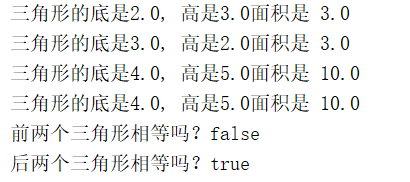实验目的:
- 理解类的多态性
- 掌握抽象类的概念
- 掌握函数重写
- 掌握toString和equals函数
- 掌握对象类型转换
实验内容:
- toString和equals函数学习
- 创建一个三角形类,有double型私有变量底、高,有构造器、更改器和访问器,求面积的方法
- 重写Object类的toString方法和equals方法,toString方法显示三角形的底、高和面积,显示方法见下图,equals方法参照教材P173或PPT编写,当底和高都相等时判断为相等。
- 编写程序,创建包含4个三角形对象的数组,自己设置高和底,用for each语句显示4个三角形对象,并分别显示两两三角形是否相等。

- 抽象类和多态学习(请认真理解抽象、多态、函数重写)
- 定义一个抽象类Staff,数据成员有姓名name(String),工资salary(double),雇佣日期hireday(hireday)。函数有:带参数构造函数;getSalary函数,返回salary;重写Object的toString函数,返回姓名、工资和雇用日期;重写Object的equals函数,当工资和雇用日期相同时认为两个对象相同;在重写函数前添加@Override抽象函数getType,返回String;抽象函数work,返回String
- 定义Employee类继承与Staff,增加用于描述身份的数据成员type(String类型),函数有:带参数构造函数,重写getType 函数,返回Type;重写work函数,返回从事的工作字符串
- 定义Manager类继承与Staff,增加用于描述身份的数据成员type(String类型),增加表示奖金的数据成员bonus(double);函数有:带参数构造函数,重写getType 函数,返回Type;重写work函数,返回从事的工作字符串,重写getSalary函数,返回salary+bonus
public class TriangleTest {
public static void main(String[] args) {
Triangle[] t=new Triangle[]{new Triangle(2,3),new Triangle(3,2)
,new Triangle(4,5),new Triangle(4,5)};
for (Triangle i:t)
System.out.println(i);
System.out.println("前两个三角形相等吗?"+t[0].equals(t[1]));
System.out.println("后两个三角形相等吗?"+t[2].equals(t[3]));
}
}
class Triangle{
private double width;
private double height;
public Triangle(double width, double height) {
this.width = width;
this.height = height;
}
public double getWidth() {
return width;
}
public double getHeight() {
return height;
}
public void setWidth(double width) {
this.width = width;
}
public void setHeight(double height) {
this.height = height;
}
public double setArea() {
return width*height/2;
}
@Override
public String toString(){
return "三角形的底是"+width+", 高是"+height+"面积是 "+setArea();
}
@Override
public boolean equals(Object otherObject){
if(this==otherObject)
return true;
if(otherObject==null)
return false;
if(getClass()!=otherObject.getClass())
return false;
Triangle other=(Triangle)otherObject;
return width==other.width && height==other.height;
}
}import java.time.LocalDate;
public class StaffTest {
public static void main(String []args) {
Staff[] s = new Staff[3];
s[0]=new Employee("Alice",3000,2002,2,5,"普通雇员");
s[1]=new Manager("Bob",5000,2000,1,5,"管理者",3000);
s[2]=new Employee("kevin",3000,2002,2,5,"普通雇员");
for(Staff e:s){
System.out.println(e);
System.out.println(e.getType());
System.out.println(e.work());
}
System.out.println("两个雇员入职时间和待遇相同吗?"+s[0].equals(s[2]));
}
}
abstract class Staff{
private String name;
private double salary;
private LocalDate hireday;
public Staff(String name, double salary, int year,int month,int day) {
this.name = name;
this.salary = salary;
this.hireday = LocalDate.of(year,month,day);
}
abstract String getType();
double getSalary(){
return salary;
};
abstract String work();
@Override
public String toString(){
return "姓名:"+name+" 工资:"+getSalary()+" 雇佣日期:"+hireday;
}
@Override
public boolean equals(Object otherObject){
if(this==otherObject)
return true;
if(otherObject==null)
return false;
if(getClass()!=otherObject.getClass())
return false;
Staff other=(Staff) otherObject;
return salary==other.salary && hireday.equals(other.hireday);
}
}
class Employee extends Staff{
String type;
public Employee(String name, double salary, int year, int month, int day, String type) {
super(name, salary, year, month, day);
this.type = type;
}
@Override
public String getType() {
return type;
}
String work(){
return "从事生产线工作";
}
}
class Manager extends Staff{
String type;
double bonus;
public Manager(String name, double salary, int year, int month, int day, String type, double bonus) {
super(name, salary, year, month, day);
this.type = type;
this.bonus = bonus;
}
@Override
public String getType() {
return type;
}
String work(){
return "从事管理工作";
}
@Override
double getSalary(){
return super.getSalary()+bonus;
};
}
版权声明:本文为weixin_43560803原创文章,遵循CC 4.0 BY-SA版权协议,转载请附上原文出处链接和本声明。